MIELE G 665 SC User Manual

Operating instructions
for dishwashers
It is essential to read these operating instructions before installing or using the machine, to avoid risk of accident
or damage to the machine.
Q
M.-Nr. 04 873 380
Downloaded from www.Manualslib.com manuals search engine

Contents
Guide to the appliance. . . . . . . . . . . . . . . . . . . . . . . . . . . . . . . . . . . . . . . . . . . . . . 3
Warning and safety instructions. . . . . . . . . . . . . . . . . . . . . . . . . . . . . . . . . . . . . . 6
Caring for the environment . . . . . . . . . . . . . . . . . . . . . . . . . . . . . . . . . . . . . . . . . . 9
Before using for the first time. . . . . . . . . . . . . . . . . . . . . . . . . . . . . . . . . . . . . . . 10
Opening and closing the door . . . . . . . . . . . . . . . . . . . . . . . . . . . . . . . . . . . . . . 11
Water softener/reactivation . . . . . . . . . . . . . . . . . . . . . . . . . . . . . . . . . . . . . . . . . 12 Setting the water hardness level/Filling the salt reservoir . . . . . . . . . . . . . . . . 12/13 Add salt indicator light . . . . . . . . . . . . . . . . . . . . . . . . . . . . . . . . . . . . . . . . . . . . . . 14
Adding rinse aid . . . . . . . . . . . . . . . . . . . . . . . . . . . . . . . . . . . . . . . . . . . . . . . . . . 15 Rinse aid dosage setting . . . . . . . . . . . . . . . . . . . . . . . . . . . . . . . . . . . . . . . . . . . . 16
Loading the dishwasher . . . . . . . . . . . . . . . . . . . . . . . . . . . . . . . . . . . . . . . . . . . 17 Loading examples . . . . . . . . . . . . . . . . . . . . . . . . . . . . . . . . . . . . . . . . . . . . . . . . . 18 Flap up racks, positioning rail, adjusting the upper basket. . . . . . . . . . . . . . . 22/23
Not suitable for dishwashers . . . . . . . . . . . . . . . . . . . . . . . . . . . . . . . . . . . . . . . 24
Adding detergent . . . . . . . . . . . . . . . . . . . . . . . . . . . . . . . . . . . . . . . . . . . . . . . . . 25
Programme selection. . . . . . . . . . . . . . . . . . . . . . . . . . . . . . . . . . . . . . . . . . . . . . 29
Programme chart . . . . . . . . . . . . . . . . . . . . . . . . . . . . . . . . . . . . . . . . . . . . . . 30/31
Switching on and off . . . . . . . . . . . . . . . . . . . . . . . . . . . . . . . . . . . . . . . . . . . 32/33 Programme change; interrupting a programme; programme sequence display. 32/33
Removing load . . . . . . . . . . . . . . . . . . . . . . . . . . . . . . . . . . . . . . . . . . . . . . . . . . . 34
Cleaning and care . . . . . . . . . . . . . . . . . . . . . . . . . . . . . . . . . . . . . . . . . . . . . . . . 35
Checking the water level/Increasing the water intake time . . . . . . . . . . . . . . . . . 41
Dealing with minor faults . . . . . . . . . . . . . . . . . . . . . . . . . . . . . . . . . . . . . . . . . . 43
After sales service . . . . . . . . . . . . . . . . . . . . . . . . . . . . . . . . . . . . . . . . . . . . . . . . 43
Special accessories . . . . . . . . . . . . . . . . . . . . . . . . . . . . . . . . . . . . . . . . . . . . . . . 44
Comparison tests. . . . . . . . . . . . . . . . . . . . . . . . . . . . . . . . . . . . . . . . . . . . . . . . . 45
Installation instructions. . . . . . . . . . . . . . . . . . . . . . . . . . . . . . . . . . . . . . . . . . . . 47
Technical data. . . . . . . . . . . . . . . . . . . . . . . . . . . . . . . . . . . . . . . . . . . . . . . . . . . . 69
2
Downloaded from www.Manualslib.com manuals search engine

Guide to the appliance
Miele dishwashers are available in three versions:
1. “Freestanding“ dishwashers
“Freestanding“ dishwashers do not require any special installation fixings in the kitchen.
A decor frame can be added to take a panel for matching the dishwasher to the kitchen fronts.
2. Integrated (“i“) dishwashers
“i“ dishwashers are specially designed for building under a continuous worktop.
The control panel with its accessories is included with the “i“ dishwasher in a separate package for on-site fixing.
The front is designed to be fitted with a base unit front to match the kitchen furniture.
The dishwasher does not have a plinth facia. The plinth area can be covered either with facia to match your kitchen furniture if available, or another facia. The separate plinth facia can be fitted to match the height of adjacent plinths. The plinth return is freely adjustable.
All notes on installation are described in the chapter on “Installation instructions“.
3. “U“ dishwashers
The built-under(“U“) dishwashers use the integrated (“i“)-dishwashers as the basic machine.
By using a decor set (GDU) the “i“ dishwasher can be converted into a “U“ model dishwasher.
GDU installation instructions are included in a separate installation leaflet supplied with the decor set.
3
Downloaded from www.Manualslib.com manuals search engine

Guide to the appliance
View of the machine
Control panel (facia)
4
Downloaded from www.Manualslib.com manuals search engine

Guide to the appliance
1Upper spray arm (not visible)
2Cutlery tray
(standard depending on model)
3Upper basket, (Design varies according to model, and may not match the one shown)
4Water duct for middle spray arm
5Middle spray arm
6Water hardness selector
7Lower spray arm
8Four height adjustable screw feet
9Filter combination
10Salt reservoir
11Dual compartment detergent dispenser
12Rinse aid reservoir (with dosage selector)
13Data plate
14Indicator lights
15Door opener
16Child safety lock
17Temperature selector
18Programme selector switch
5
Downloaded from www.Manualslib.com manuals search engine

Warning and safety instructions
This appliance conforms to current safety requirements. Inappropriate use can however lead to personal injury and damage to property. Read the operating instructions carefully before starting to use this machine. This way you will avoid the risk of accidents, and damage to the machine. Keep these instructions in a safe place for reference, and pass them on to any future user.
Appropriate usage
This dishwasher is intended exclusively for cleaning domestic croc-
kery and cutlery. Do not use for purposes other than those for which it was designed. Unauthorised use could prove dangerous.
The manufacturer cannot be held responsible for any damage caused by improper use or for uses other than those for which the appliance is intended.
The following notes are to help avoid personal injury
To ensure stability integrated and built-under models must be in-
stalled under a continuous worktop which has been firmly screwed to neighbouring units.
The electrical safety of this appliance can only be guaranteed
when continuity is complete between the appliance and an effective earthing system. It is imperative that this basic safety requirement is tested and where there is any doubt the electrical system in the house is checked out by a qualified electrician. The manufacturer can-
6
not be held responsible for damage caused by the lack or inadequacy of an effective earthing system, (electric shock for example).
For safety reasons do not operate this appliance on an extension
cable. Danger of overheating.
A damaged appliance is dangerous. Switch off at the mains and call the
Service Department for assistance.
Repairs may only be carried out by suitably qualified and competent
engineers to ensure safety. Repairs by unqualified persons could be dangerous.
With the "Waterproof system", the plastic housing of the water inlet
connection contains an electrical component. It must not be dipped in water.
Do not let small children play with the dishwasher and its controls or
operate it.
There is a danger that children playing might shut themselves in the dishwasher. Please supervise its use by the elderly or infirm.
Do not use solvents in the dishwasher. Danger of explosion!
Avoid inhalation of powder detergents.
For appliances with the heating element in the wash cabinet do not
touch the element during or directly after the end of a programme, you could burn yourself.
Downloaded from www.Manualslib.com manuals search engine

Warning and safety instructions
Dishwasher detergents contain irritant or corrosive ingredients. They
can cause burning in the mouth and throat if swallowed, or inhibit breathing. Keep children away from detergents and from the dishwasher when the door is open. There could be detergent residues in the appliance.
To avoid the danger of children coming into contact with the dish-
washer detergent: Only put it into the detergent dispenser just before starting the programme, and then secure the door with the child safety lock.
For models with "Delay Start" option make sure the detergent dispenser is dry before putting in detergent. Wipe dry if necessary. Detergent will clog if poured into a damp dispenser and may not be thoroughly dispensed. If the door is open at the end of a programme, children may come into contact with this residue.
Water in the dishwasher must not be used as drinking water.
Appliances with a cutlery basket: items of cutlery are cleaned and
dried more efficiently if placed in the basket handles downwards. You may however, prefer to place cutlery with sharp points with the handles upwards.
Always disconnect the appliance from the electrical supply for main-
tenance work (switch off at wall socket and remove plug, screw out fuse in countries where this is applicable).
The following notes should help to avoid material damage
The voltage and frequency shown on the data plate must match the
mains supply in the house.
Only use detergents formulated for domestic dishwashers. Do not use
washing-up liquid.
Do not use commercial or industrial detergents as these may dam-
age material and there is a risk of severe chemical reaction.
Inadvertently filling the salt reservoir with dishwasher detergent al-
ways leads to damage to the water softener. Make sure that you have picked up the right packet of dishwasher salt before filling the salt reservoir.
Inadvertently filling the rinse aid reservoir with powder or liquid detergent always leads to serious damage to the reservoir. Only use rinse aid formulated for domestic dishwashers.
Do not sit or lean on the opened door. This could cause the dish-
washer to tip and be damaged.
If your dishwasher has the heating element visible in the base of the
wash cabinet, as far as possible always place plastic items in the top basket, and ensure they do not drop through. The plastic could melt or lose its shape near the heating element.
7
Downloaded from www.Manualslib.com manuals search engine

Warning and safety instructions
The Miele Waterproof System offers protection from water damage,
provided the following conditions are met:
–the dishwasher is correctly installed and plumbed in
–the dishwasher is properly maintained and parts are replaced where it can be seen that this is necessary
–the stopcock has been turned off when the machine is not used for a longer period of time (e.g. during holidays).
In countries where there are areas which may be subject to infesta-
tion by cockroaches or other vermin, pay particular attention to keeping the appliance and its surroundings in a clean condition at all times. Any damage which may be caused by cockroaches or other vermin will not be covered by the appliance guarantee.
Disposal of your old machine
When disposing of an old dishwasher first make it unusable. Dis-
connect, cut off the cable and the plug from the cable.
Make the door lock inoperative, so that children cannot accidentally shut themselves in. Make appropriate arrangements for the safe disposal of the appliance.
The manufacturer can not be held responsible for any damage caused by non-observance of the Warning and Safety instructions.
8
Downloaded from www.Manualslib.com manuals search engine

Caring for the environment
Disposal of the packing material
The transport and protective packing has been selected from materials which are environmentally friendly for disposal and can normally be recycled.
Rather than just throwing these materials away, please ensure they are offered for recycling.
Disposal of your old machine
Old machines contain materials which can be re-cycled. Please contact your local authorities or scrap merchant about potential recycling schemes, before disposing of the appliance.
Energy saving washing
These dishwashers are exceptionally efficient in their use of water and electricity. You can make the most of your appliance by following these tips:
If your household water system is suitable, this dishwasher can be connected to a hot water supply, for further economies.
However, if your water is heated by electricity we would still recommend connection to cold water.
In the UNIVERSAL 55° programme, depending on the capacity of the dishwasher, when connected to hot water at 55°C up to 0.7 kWh of electrical energy is saved. The hot water provides this energy, and the approx. 0.13 l oil or 0.14 m3 natural gas needed to heat the water might be considerably more cost effective. Although all stages of the wash then take place with hot water, savings are made in cost, time and energy.
Make full use of the baskets without overloading the dishwasher for most economical washing.
Choose the programme to suit the type of crockery being washed and the degree of soiling.
If baskets are only half full use the ECONOMY programme.
Use the correct dosages of detergent.
9
Downloaded from www.Manualslib.com manuals search engine

Before using for the first time
Before using for the first time please note the following points:
See the relevant chapters for detailed information on the points below.
Setting the water softener
The water softener unit must be set to deal with the water hardness level in your area.
The salt reservoir must also first be filled with water and then with dishwasher salt. Never fill with dishwasher powder detergent.
Filling the salt reservoir with detergent by mistake will cause serious damage to the water softener.
Please check every time before refilling that the package contains dishwasher salt.
Add rinse aid
Inadvertently filling the rinse aid reservoir with powder or liquid detergent, or washing up liquid, will cause serious damage to the reservoir.
Only use rinse aid formulated for domestic dishwashers.
Do not use washing up liquid
Only use detergent formulated for domestic dishwashers.
Load the crockery correctly
Load the crockery so that water will come into contact with all surfaces.
This ensures that they will be properly cleaned.
10
The spray arms must not be blocked by items which are too tall for the basket or which hang through. If necessary manually rotate the spray arms to test.
Add the correct amount of detergent
Follow the detergent manufacturer’s recommendations on how much detergent to use. Not using enough will lead to poor wash results. The amount to dispense will depend on the type of detergent and programme selected.
Read the notes on dosage given in the programme chart.
Cleaning results may vary from brand to brand. If you are not satisfied with the results from one brand try another quality brand before contacting the Customer Service department for advice.
It is important to choose the correct programme
The UNIVERSAL programmes are ideally suited to everyday loads. See the programme chart for descriptions of other programmes.
The filter combination in the base of the wash cabinet and the spray arms must be kept clean.
These should be regularly inspected and cleaned if necessary.
Downloaded from www.Manualslib.com manuals search engine

Opening and closing the door
To open the door |
|
Child safety lock |
|
|
|
|
|
|
Press the release catch inside the door grip.
If the door is opened during operation all functions are automatically interrupted.
To close the door
Push the baskets right in
Lift the door upwards and push until it clicks into position
The child safety lock is designed to deter children from opening the dishwasher door.
Use the key provided to turn the child safety lock to the required setting.
Horizontal setting = The door is locked.
Vertical setting = The door can be opened.
11
Downloaded from www.Manualslib.com manuals search engine
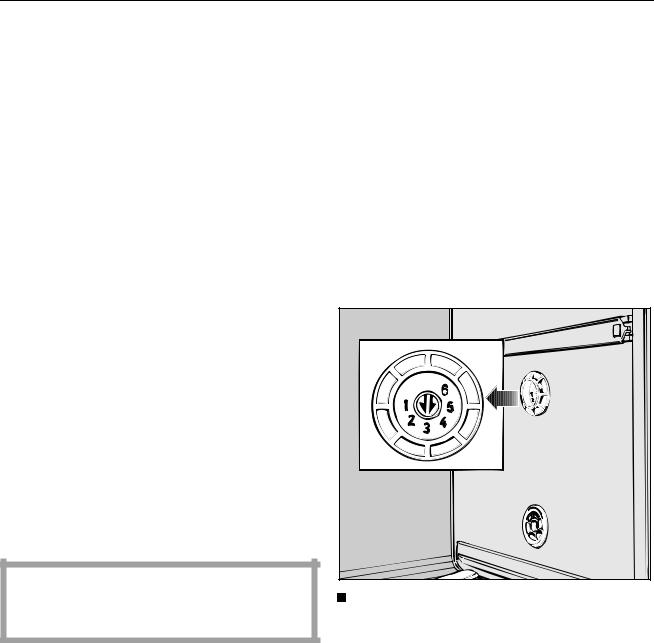
Water softener
It is not necessary to reactivate with salt if the degree of hardness in the local supply is permanently under 70 mg/l, (0.7 mmol/l, or 4 °d German scale).
Your local water supplier will advise you on the water hardness of your area.
Above 70 mg/l (0.7 mmol/l, or 4 °d German scale) water must be softened. This is to avoid the build-up of calcium deposits on crockery and cutlery, and in the dishwasher, and also to increase the effectiveness of the detergent.
To ensure a steady supply of soft water the built-in water softener must be:
1.correctly set and
2.the salt reservoir must be filled with dishwasher salt for reactivation.
The dishwasher is set at the factory to operate to a hardness level of
400 - 630 mg/l (4.0 - 6.3 mmol/l, or 22 - 35 °d German scale).
If your water is harder or softer than this the factory setting will need to be adjusted.
Setting the water hardness level selector in the wash cabinet
There are six settings on the selector.
Setting |
°d |
mg/l |
°f |
|
|
|
|
1 |
4-14 |
70-250 |
7-25 |
2 |
15-21 |
270-380 |
27-38 |
3* |
22-35 |
400-630 |
40-63 |
4 |
36-47 |
650-850 |
65-85 |
5 |
48-65 |
860-1170 |
86-117 |
6 |
66-70 |
1190-1260 |
119-126 |
|
|
|
|
* factory setting
Use a coin or screwdriver to adjust the water hardness level selector in the wash cabinet. There is a click as each setting is reached.
Example:
The water hardness level is 320 mg/l.
The water hardness level selector must be set to setting 2, 270 - 380 mg/l
(15 - 21 °d German scale).
12
Downloaded from www.Manualslib.com manuals search engine

Water softener
Filling the salt reservoir
Please only use special coarse grained dishwasher salt for reactivation, as other salts may contain insoluble additives which can impair the functioning of the softener.
The salt reservoir holds approx. 2 kg of salt.
Inadvertently filling the salt reservoir with dishwasher detergent always causes serious damage to the water softener.
Make sure that you have picked up the right packet of dishwasher salt before filling the salt reservoir.
Remove the bottom basket.
Unscrew the salt reservoir cap.
Before filling the salt reservoir for the first time:
Fill the salt reservoir with approx. 2 litres of water.
Place the funnel (provided) in place.
Fill carefully with salt
(As it is filled displaced water will run out).
Clean salt from the screw threads of the socket.
Screw the cap on firmly.
Run the “COLD PRE-WASH” programme immediately to remove any traces of salt water from the cabinet. This is not necessary if a “UNIVERSAL” or “UNIVERSAL PLUS” programme is run straight away.
13
Downloaded from www.Manualslib.com manuals search engine

Water softener
Salt indicator
Note
With very soft water, i.e. constantly at a level below 70 mg/l (4 °d), the reservoir does not have to be filled with salt and although the salt light does come on, this can be disregarded.
When the salt reservoir is empty the “Salt” indicator light comes on. The reservoir should be refilled with dishwasher salt for reactivation.
14
Downloaded from www.Manualslib.com manuals search engine

Adding rinse aid
Rinse aid is necessary to ensure that water does not cling and leave marks on crockery during the drying phase. Rinse aid is poured into the storage reservoir and the amount set is dispensed automatically.
The rinse aid reservoir holds approx. 130 cm3.
Inadvertently filling the rinse aid reservoir with powder detergent (or liquid detergent) always causes serious damage to the reservoir. Only pour rinse aid formulated for domestic dishwashers into the reservoir.
Although it is possible to use household vinegar with a max. 5% acid content, or liquid citric acid up to 50% acid as an alternative, the resulting rinsing and drying quality will not be as good as when rinse aid is used.
Do not use vinegar with a high acid content (e.g. vinegar essence 25% acid). This must not be used as its use would damage the dishwasher.
Add rinse aid when the indicator light “Rinse aid” on the control panel comes on.
Press the button (in the direction of the arrow) until the flap springs open.
15
Downloaded from www.Manualslib.com manuals search engine

Adding rinse aid
Setting the dosage
Add rinse aid only until it is visible on the surface of the filter in the opening.
Close the flap firmly.
The flap must audibly engage, otherwise water could get into the rinse aid storage container during the programme.
Mop up any split rinse aid. This prevents over-forming occuring during the next programme.
The flap should normally remain closed. Only open it for adding more rinse aid!
Wait until the ”Rinse aid” indicator on the control panel lights up before adding more rinse aid.
The dosage adjuster (see arrow) in the opening has settings from 1 to 6. It is set to 3 at the factory, as the recommended dose.This setting dispenses approx. 3 ml rinse aid per programme.
If there are flecks on glasses after drying use a higher setting.
If smearing appears on crockery use a lower setting.
16
Downloaded from www.Manualslib.com manuals search engine

Loading the dishwasher
Note
Load the crockery so that water will come into contact with all surfaces. This ensures that they will be properly cleaned.
Do not place crockery and cutlery inside other pieces where they may be concealed.
Hollow items e.g. cups, glasses etc. must be inverted in the basket.
Deep based items should be placed at an angle such that water runs off them freely.
Tall narrow hollow pieces should be placed in the centre of the basket, rather than in the corners, to ensure good coverage of water.
Small pieces should be placed on the cup racks. Cups should be on the lower rack and bowls on the top rack so that water reaches all pieces.
The spray arms must not be blocked by items which are too tall for the basket or which hang through.
If necessary manually rotate the arms to test.
Some foodstuffs may contain natural dyes, e.g. carrots, tomatoes or ketchup. Plastic items in the dishwasher may discolour if large quantities of these foodstuffs find their way into the appliance on the crockery.
The stability of the plastic items is not affected by this discolouration.
17
Downloaded from www.Manualslib.com manuals search engine
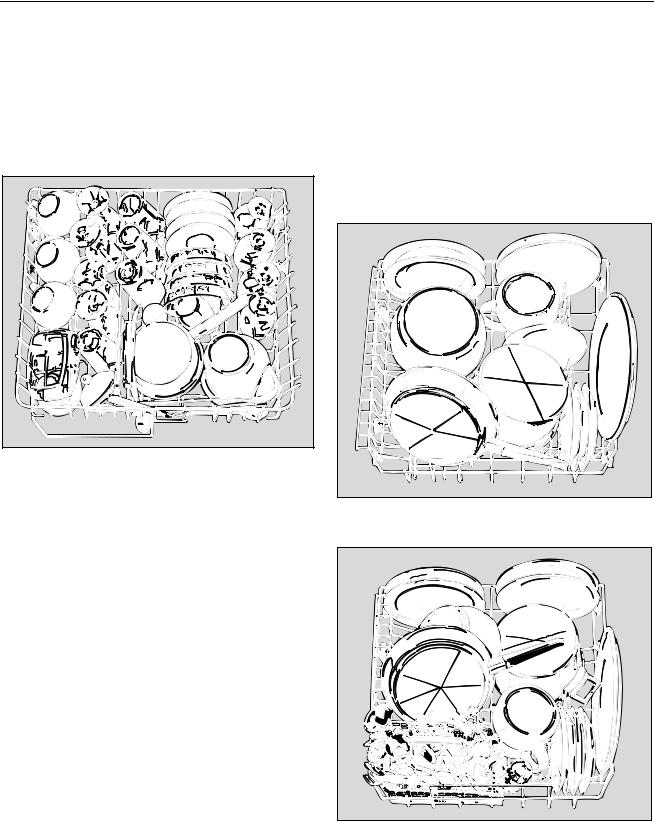
Loading the dishwasher
Loading examples
Upper basket
Small, lightweight, delicate items such as cups, saucers, glasses, dessert bowls, etc.
Bottom basket
Larger and heavier items such as plates, serving platters, saucepans, bowls. Depending on the dishwasher model glasses may only be cleaned in the bottom basket if it is fitted with a special glassware insert or if there is a special bottom basket.
Dishwashers with cutlery tray
Dishwashers with cutlery basket
18
Downloaded from www.Manualslib.com manuals search engine
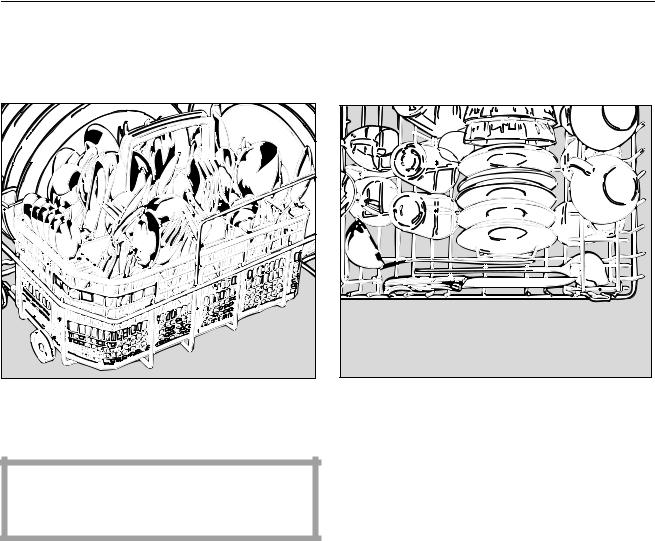
Loading the dishwasher
Cutlery
Dishwashers with cutlery basket:
Unsorted cutlery should be placed in the cutlery basket, handles facing downwards.
You may, however, prefer to place cutlery with sharp points with the handles upwards.
Place small spoons in the individual slots to either side of the cutlery basket.
Larger items like soup ladles, long knives and mixing spoons should be placed lying down across the front of the upper basket.
19
Downloaded from www.Manualslib.com manuals search engine
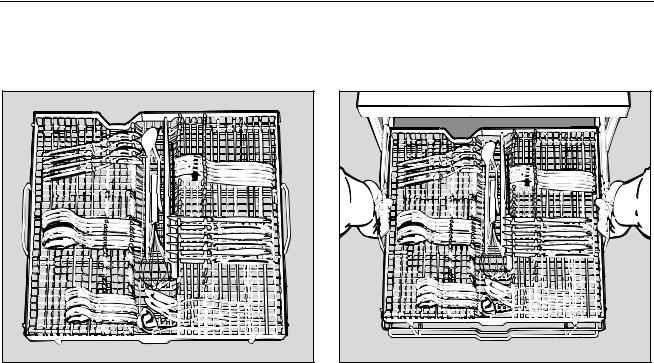
Loading the dishwasher
Dishwasher with cutlery tray (SC models):
For best results cutlery should be grouped in zones, one for knives, one for forks, one for spoons etc. This makes unloading much easier.
Larger items like sauce ladles, cake slices, long knives and mixing spoons can be placed lengthwise in the trough in the centre of the tray.
The cutlery tray insert is removable. It can be completely removed from its frame and carried to the cutlery drawer, or table where it can be easily unloaded.
20
Downloaded from www.Manualslib.com manuals search engine
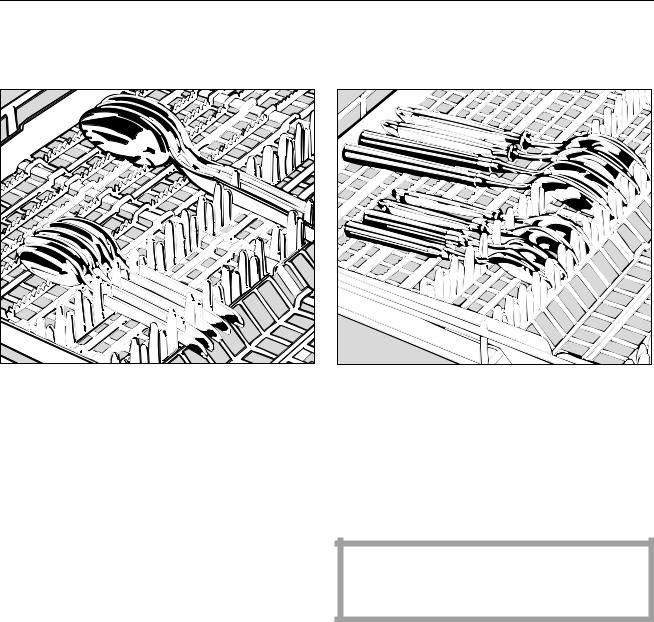
Loading the dishwasher
Spoon heads should be placed in such a way that water runs off them freely.
Cutlery with round or oval handles should be placed with the heads in the grips as this prevents them slipping.
Ensure that spoon heads are in contact with at least one of the grips in the cutlery tray. This way they cannot collect water.
The upper spray arm must not be blocked by items which are too big, e.g. cake slices.
21
Downloaded from www.Manualslib.com manuals search engine

Loading the dishwasher
Flap up racks
Can either be used for a second row of cups or raised upwards to make room for tall items.
22
Positioning rail
(standard feature depending on model)
For easy sorting and removing of crockery the positioning rail can be rested to one side.
Raise it again afterwards so that crockery can rest against it in the basket.
Downloaded from www.Manualslib.com manuals search engine
